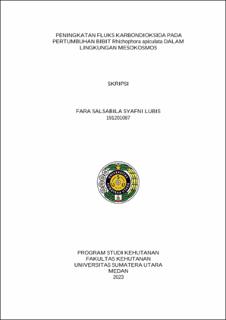Peningkatan Fluks Karbondioksida pada Pertumbuhan Bibit Rhizhophora apiculata dalam Lingkungan Mesokosmos
Increased Carbon Dioxide Flux in the Growth of Rhizhophora apiculata Seedlings in a Mesocosm Environment

Date
2023Author
Lubis, Fara Salsabila Syafni
Advisor(s)
Basyuni, Mohammad
Metadata
Show full item recordAbstract
Mangroves are coastal ecosystems with plant species that have a wide tolerance range and have resistance to environmental stress conditions. R.apiculata is one of the mangrove plants that are commonly found in coastal areas and is a major component of mangroves and can grow in areas with moderately hard mud as well as shallow, muddy, sandy, and flooded by daily tides and can form pure stands. Mangrove ecosystems have enormous mitigation potential to address catastrophic climate change due to global warming. An important process in the dynamics of CO2 gas between the atmosphere and seawater known as CO2 flux. The emission and absorption of CO2 gas in the atmosphere are considered uncertain, so the process of carbon dioxide transfer must be analyzed by monitoring the CO2 flux. Therefore, knowledge is needed about the influence of tides and ebbs on increasing CO2 fluxes and the influence of waves and salinity on the growth of R. apiculata seedlings in the mesocosmic environment as a consideration for parties carrying out restoration activities in mangrove forests so that the success rate of restoration is better. Windows of Opportunity (WoO) is a disturbance-free period to determine the intrinsic time of organisms in the growth process. Comparison of R. apiculata growth in this study used 10% and 30% salinity and waves treatment and no waves treatment. CO2 flux was measured using Eosense Eosgp CO2 sensor with static close chamber method. CO2 flux as well as the yield and growth of R. apiculata seedlings were analyzed by descriptive statistical analysis method. The results showed that root growth in R. apiculata seedlings with 10% salinity was better than 30%. R. apiculata roots grow better in an environment with waves than without waves. The suitable period for R. apiculata root growth was 0 to 3 days. The highest increase in CO2 flux was found in the wave treatment during high tide conditions with an average of 285.32 mgCO2/m2/h and WoO 10 during high tide conditions with an average of 281.32 mgCO2/m2/h. This proves that simulated tides, salinity differences, and treatments with waves and without waves affect the root growth of R. apiculata seedlings, and tidal conditions have an effect on increasing CO2 flux.
Collections
- Undergraduate Theses [1996]
